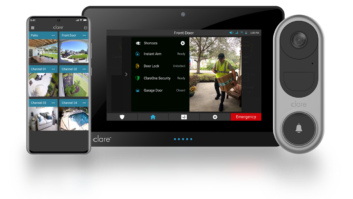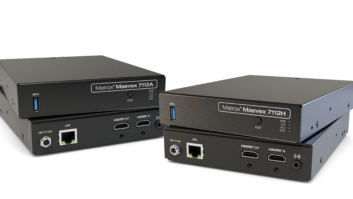Had Christopher Columbus gone to last month’s International Consumer Electronics Show in Las Vegas, he would have found as much evidence to the rise of flat, thin screens as his navigating the oceans proved that the world was round. These screens were not only flat, but, of course, high-definition and with built-in HD tuning and other connectivity features well in advance of the demands of the FCC’s tuner mandate.
The world is flat? You bet. In the true “flat/thin” part of the world the contenders remain LCD and plasma (PDP), and from a technology standpoint that remains. At CES there were all sorts of interesting items in both fields that will further push things in the flat/thin direction.
Super-Size Flat Panels. To the world outside our industry, which is to say the consumers who use our products and services, the news may have been in the battle for “World’s Largest,” which actually rocked back and forth during CES. At the show’s end, Samsung held the title of “biggest” for both PDP and LCD with 80-inch-wide and 57-inch-wide models, respectively. Archrival LG was not far behind, with 76-inch-wide PDP and 55-inch-wide LCD sets shown on their stand. Importantly for HD, all of these sets deliver true 1920×1080 resolution.
Bigger is almost always seen as better, so the popular and financial press coverage of these flat-panel giants was strong. One, however, has to be careful in dealing with the consumer interest that all of this coverage generates. The large plasma sets have no availability dates yet, and you should not expect to see them until very late this year, and maybe not until 2005. The LCDs may be a bit closer in, with Samsung quoting second-quarter availability for their 57-inch-wide unit and LG quoting fourth-quarter availability of the 55-inch-wide unit, both as totally integrated products with built-in tuners for off-air and cable.
LCDs on the Rise. While the attention was in the super-large sets, the real action for the flat-panel world appeared to be in the mid-40-inch screen size for LCD. Leading the pack was the announcement of 45-inch-wide LCD sets from Sharp, to be available in the spring. Despite the fact that the still unannounced pricing is likely to be more than comparably size PDP panels, the new 45-inch models from Sharp’s brand new “Generatio 6” LCD plant have the advantage of 1920×1080 resolution, along with LCD’s other strong points of freedom from burn-in, problem-free operation at high altitudes and longer life. Still positioned in the minds of many as a technology for desktop monitors rather than full-motion video displays, these new Aquos models should help push LCD into the front ranks for large-screen, direct-view monitors.
While Sharp and the established Korean LCD vendors (Samsung and LG) are beginning to produce a wide range of models in the 40-inch-wide and over size range (dominated in recent years by PDP) additional news that will likely impact your business was the emergence of the “new/old” brand names such as Westinghouse Digital and Motorola/Moxell using panels sourced from Taiwanese fabs. Long a source for the LCD panels used in computer monitors and laptops, LCD fab facilities in Taiwan are starting to churn out 46-inch-wide and 47-inch-wide panels. Though their production lines are not as efficient as Sharp’s new plant and some of the Korean fabs, the Taiwanese suppliers have committed to moving beyond the desktop and into the home theater.
Unlike the Japanese and Korean business models where the fabs are typically owned by companies that also produce finished goods, the model here is for the fabs to sell the raw “glass” modules that are typically integrated into completed products by intermediary OEM/ODM manufacturers. With the “old-new” brand names, as well as other familiar names, these products will change the dynamics of the display world.
Using these brands that they hope still have some positive equity in the display arena, the competition will come from new entrants in the 46-inch-wide and 47-inch-wide category, as well as a wide range of other LCD and possibly PDP sizes. For some custom installers these brands may present a lower priced alternative to their conventional suppliers. For others, these “new-old” brands, along with others such as BenQ, may become the mass-market competition that beats you over the head with highly competitive pricing in the Sunday newspaper circulars each week. Whether you join them or fight them off, these products are going to become an important factor in shaping consumer perception for the quality and feature level of large-screen LCD panels, as well as for the pricing attached to them. Whichever route you choose, awareness of these products is going to be critical for you in the months ahead as they begin to reach the market sometime in late spring and into the summer.
Competition for your customers’ dollars in LCD panels space will see an increase from the computer side of the market as well. Gateway has already established themselves as a major purveyor of PPS, now in both HD, as well as ED resolution. They have added LCD to their mix, as has fellow direct marketer Dell. Taking a cue from their own competition, HP will become the next major brand to sell “LCD televisions,” as announced at CES. The moral of this story is obvious: spruce up your own product mix, emphasize quality and features for the products you carry, and doubly emphasize your own value-added services to install these products properly.
Plasma and DLP Developments. Although LCD may have captured more popular press news at CES, a complete report on the display activity must include mention of not only the new “super-size” panels that are off in the distance, but also of the first appearance of a “home-made” 61-inch-wide plasma from Panasonic using their Plasmaco technology and a domestic facility for limited initial production. Those with long memories will remember that Panasonic was actually the first company to show a 60-inch-wide panel, but they were never quite able to bring it into production. Apparently, the bugs have been ironed out and we will soon see this size in their line up, not to be confused with other 61-inch-wide panels using plasma modules sourced from NEC. Additional “new size” news is the appearance of the 55-inch-wide plasma sets using modules from the Fujitsu/Hitachi production venture, first shown at CEDIA EXPO, under the Hitachi brand name.
Looking further to prove that the world sees things as being flat, rather than round, one of the bigger news flashes from CES was the introduction of rear-screen, HD-2 DLP projectors from RCA and InFocus that are under 6.8 inches deep. Initially available in 50-inch-wide and 61-inch-wide sizes from RCA and a 61-inch-wide size from both brands, these models are not quite as thin as the under four-inch PDP and LCD models, but they will compete very favorably with the panels on price. Things will heat up even further next year when RCA introduces a 70-inch-wide product in this technology configuration.
Will these super-thin sets heat up the price competition between PDP, LCD, LCoS and DLP units? Given the attention they received in the press during and after CES, the answer is most likely a yes. Carry them or not, it is certainly going to build yet more attention and hopefully traffic in your establishment for this type of display.
Elsewhere in the display world, CES saw a number of other important announcements. On the DLP side, Texas Instruments highlighted their product roadmap for the next 24 months. Along with the current HD-2 chips that are now almost universal for front- and rear-screen applications, an HD-2+ model will add enhancements for improved contrast, while an HD-3 model will offer yet more image improvements. Looking toward the end of the year, the first 1080P chips will be available for “productization” using “XHD-3” DLP imagers.
While DLP has scored a number of impressive design wins, with RCA and Toshiba both offering wide ranges of new DLP models where they had once been LCoS adherents, LCoS is far from out of the picture. JVC will resume use of its D-ILA technology in RP sets with 52-inch-wide and 61-inch-wide models using 1280×720 chips. As will be the case with many of the new RP units and integrated PDP and LCD models, regardless of their image technology, these products will have HDMI connectivity for plug ‘n play with the latest generation of HDTV source products.
CRT and LCoS Live Another Day. Another big CES newsmaker was the long-anticipated announcement by Intel that it will offer LCoS chips for integration into projection light engines later this year. The chip giant did not provide complete details, but it is clear that this move will also put more pressure on display technologies of all types to compete on price, and hopefully on quality as well. Intel will eventually offer both 720P and 1080P LCoS chips that will appear in sets with brand names that are yet to be announced. If Intel can combine with the five light engine developers they are working with to achieve their goal of price parity with DLP for the “guts” of a projector, it will be interesting to see where finished-goods pricing goes.
Putting all of this display news together, it does begin to spell a closer time frame for the end of CRTs for rear-screen displays, just as DLP, LCD and LCoS have all but eliminated CRT from front-projection products. Mind you, CRTs aren’t going away tomorrow. They will still be the core of RPTV for at least a few more years, and until LCD pricing drops even further, CRT will still be the mainstay for displays under 30 inches.
Flat-Panel Connectivity Concerns. The great appeal of flat/thin displays is certainly their ability to hang on a wall. Unless, however, they are nuclear powered, solar powered or contain a cage where thin hamsters run on a treadmill that turns a generator, all displays need a power source at the very least. Then, again, regardless of their technology, you have to find some way to connect the various input sources that are required. In some cases this is a single cable from an external control center or external video switcher. But, in many more cases, it will be a plethora of RF, component video, composite or S-Video, DVI or HDMI digital video and perhaps audio, as well. Sure, as installers we can do our best to run all of these through the wall, but sooner or later they need to exit and connect to the display. Again, not so bad when the display is hard-fixed in a specific position, but more complicated when a thick bundle of cables has to follow the axis of support arms.
Riding to the answer will be a number of technology options that you may wish to choose from in the months and years ahead. Rather than have a spaghetti bowl of cables to a new integrated HDTV display, manufacturers seem to be suggesting that the future will require only a power connection, with hard-wire connections going to an external box that, in turn, connects wirelessly to the display. Some, such as Toshiba look to the future and Ultra Wide Band (UWB) technology, others such as Samsung suggest that 802.11a is the way to connect an STB to a display, while JVC takes an even more novel approach by using what it calls “eye-safe” laser-based optical technology to send full-bandwidth HD transmissions to a display at well over 1GB/s at a 33-foot range.
Worried about the threat from wireless products because they presumably reduce the need for consumers to have you run wires through walls? Don’t be. All of these products still require configuration and integration that an installer is best suited to provide. It is up to you to present that message to your customers and prospects.
News HD Discs Formats. Moving away from the display world, other “flat/thin” products made news at CES. Those thin items were optical discs in a variety of flavors. Most notably, in the DVD world the battle between BluRay and the HD-DVD format continues. While the latter has the approval of the DVD Forum, neither of the initial proponents (Toshiba and NEC) have announced introduction dates. On the BluRay side, where a larger and ever-increasing number of supporters still make this a format to acknowledge, Sony had previously said at CEDIA EXPO that the U.S. introduction is some time in 2005. However, at CES the schedule for BluRay moved closer, with LG stepping up with a BluRay recorder that not only features a DVD drive, but a 200 GB hard drive for HDTV time-shift, NTSC and ATSC tuners, DVI and 1394 digital connectivity and conventional DVD/CD playback. This full-featured model does not yet have a price, but it will be available in the third quarter of this year, 12 months ahead of the previous BluRay introduction schedule for the U.S.
Competing with products that use blue lasers for HD recording and playback via DVD, Microsoft and others continue to promote the use advanced compression schemes to fit HD programming on discs playable with existing red laser DVD products. Players compatible with Windows Media 9 that playback DVDs with HD programming were shown as prototypes, though it remains to be seen if a significant number of high-profile titles will be available to support these, or any of the proposed DVD systems for HD playback. This one isn’t over yet.
With space running out, there is much more to talk about, but we’ll leave that to individual category reports over the next few months. Some highlights, however, include an increasing number of display products that feature not only DVI and HDMI but QAM tuners and CableCard slots for access to digital and HD cable programming with easy connection to a set-top, or no set top at all! On the satellite side of the fence, an announcement at CES is certain to change the landscape dramatically, as DirecTV announced that they will gradually transition from their current model with differentiated products designed by, and sold under a wide range of brand names to a single interface for all products used to access the service and, much like the way arch-rival EchoStar operates, offering them only under the brand name of the service.
Michael Heiss ([email protected]) is a technology and marketing consultant based in Los Angeles.







